IN THE FOOTSTEPS OF DAVID R. ROSS "DUNADD HILL FORT" |
"Stronghold of Dalriada - Kingdom of the Scots" |
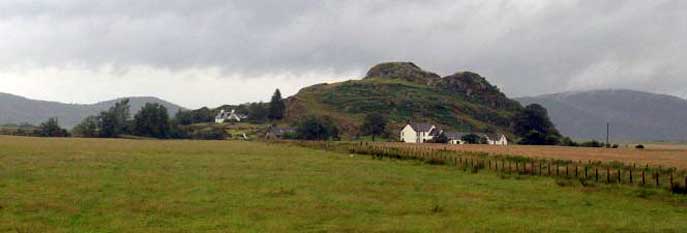 |
I first heard of Dunadd from my good friend and Pictish expert RON HENDERSON who told me that he reckons this should be a place of pilgrimage for every Scotsman, woman & child and do you know after seeing it myself I totally agree with him. I set off once again with my trusty copy of DESIRE LINES in search of my forefathers ancient kingdom. Dunadd is one of the most famous historic sites in Scotland, but sadly not enough people know about it. Let's see if we can change that shall we? By tradition, it was the capital of the early Scottish kingdom of Dalriada, founded by Fergus Mor in about AD 500, and the probable site where their kings were inaugurated. |
 |
 |
| The main approach is up a rocky defile to the lowest terrace, which has a well-defined wall. Near the north end is a solidly built wall. Above this level, the walls are more ruinous. When you get to the top the views are stupendous, my wee mind works overtime in places like this as I sit and wonder at what went on in this very place so many years ago. One of the most remarkable features is a series of carvings on a rock slab near the summit. There is a figure of a boar, the outline of a footprint, a rock-cut basin and several lines from an inscription in an unknown language. The basin and footprint are said to have been used in the inauguration of the kings of Dalriada. Rising as a rocky outcrop in Moine Mhor (or Great Moss), one of the most extensive areas of raised bog in Scotland, Dunadd is one of the most important archaeological sites in Scotland and has had an important role in forging our nation. |
 |
 |
At 175 feet tall it takes only a little imagination to picture the strategic strength of the site. Little remains of the original 4 lines of wall and what does is often shrouded by thick bracken, but even following the path to the top you are forced to zig zag your way up clambering over the rocks as you go, each time with a ridge of stone above you. Finally two gaps form easily defended gateways before the summit is reached. Couple this with the fact it sits surrounded by marshlands, with 360’ views, a river at its foot and a good well on its upper terrace and you could hardly ask for a better natural fortification. |
 |
 |
| When you get to the top, I dare you not to put your foot in the rock, you will I know you will, you wont be able to help yourself, right where was I, oh yes, the history lesson. Dunadd became the capital of a kingdom spread across the north of Ireland and increasingly encroaching on the territory of the Picts. As well as an excellent fortification and seat of kings it was also a centre of metalworking, producing fine jewellery and brooches and with trade links throughout the British Isles and Europe. There is some speculation that this may be where the Hunterston Brooch was made, one of the finest pieces of work from this period anywhere. Perhaps the best known and most enigmatic features of the fort are the fine rock carvings to be found just below the summit. What can be clearly seen is a rock cut bowl, which still holds water today, an incised boar, a footprint (size 7?), and a few lines of Ogham script (an ancient alphabet). |
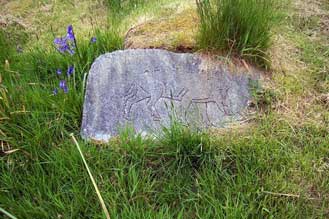 |
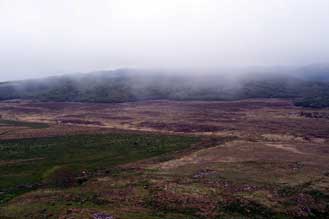 |
| It has long been held that it was this very spot that saw the inauguration of the early kings. The details of the ceremonies are lost to us now, but there is a tradition of carved footprints throughout Scotland and Ireland used either to install a new king or for lesser kings and chieftains to swear their loyalty. In times when the fate of a land was believed to be inextricably linked to the fate of its king, who could ask for a better symbol than planting your foot into the living bedrock at the summit of your greatest stronghold, thus making a very physical connection. Could this also be a possible oath to follow in the footsteps of your ancestors (quite literally) and continue the proud tradition of your people. It was from here that the Scots were to eventually overwhelm the neighbouring Picts, really reaching a point of no return when Kenneth MacAlpin was declared king of both Scots and Picts in 843AD. This he achieved through a combination of birthright and (alleged) treachery, all under increasing pressure from the marauding Vikings. |
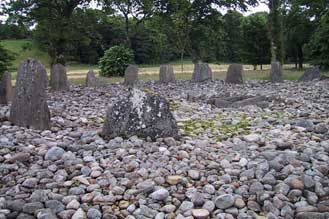 |
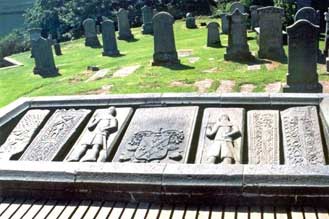 |
You will get to Dunadd Hillfort by taking the road to Lochgilphead (about 24 miles past Inveraray on the south road) and then taking a right to the Oban road. Dunadd Hillfort is about 7 or 8 miles up the Oban road. The Fort is open for visitors with car parking and information boards. Pick a good day for it. It is really a wonderful place for Scots to visit. When you are done with the Fort have a look at the various standing stones that are all over the place. And then take a pop into Kilmartin folk museum and shop. (some of RON HENDERSON carvings are in there). After that you must go and have a look at the carved stones in the grounds of Kilmartin church. And finally if you're hungry after all that walking, nip into the Kilmartin hotel for your grub. It should be compulsory for Scottish school children to make at least one trip to this place. Some of the standing stones and burial cairns around there were old when the Pyramids were built. "We are who we are!" |
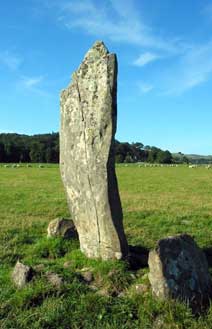 |
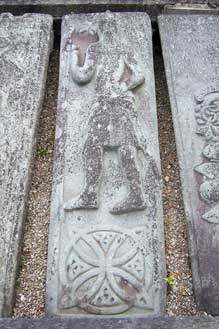 |
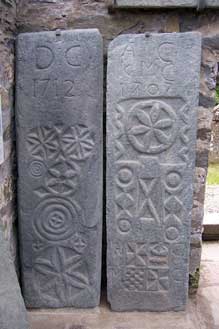 |
 |
© Paisley Tartan Army 2008-09
